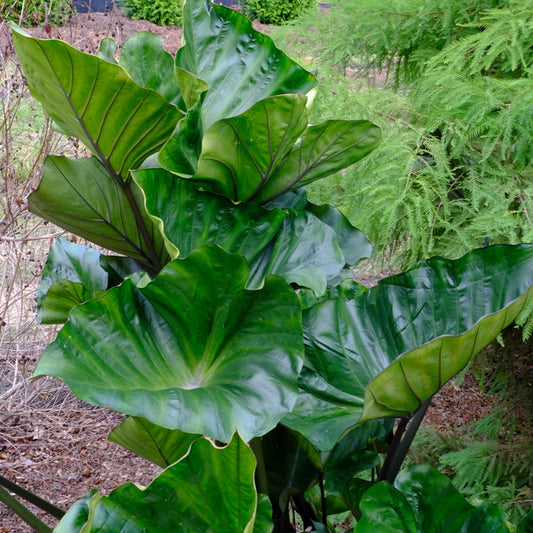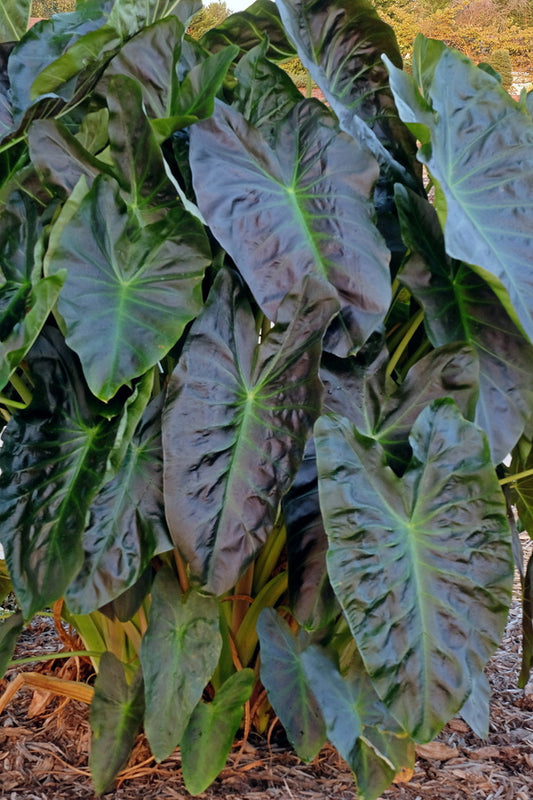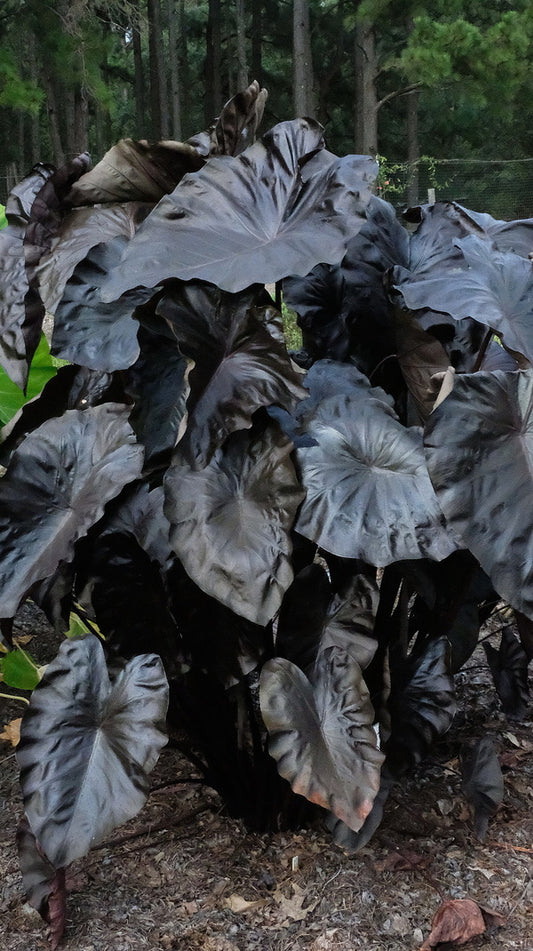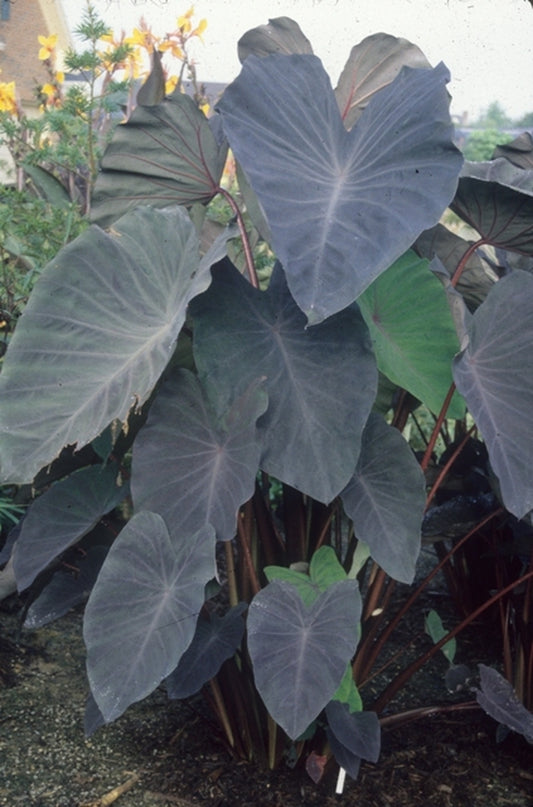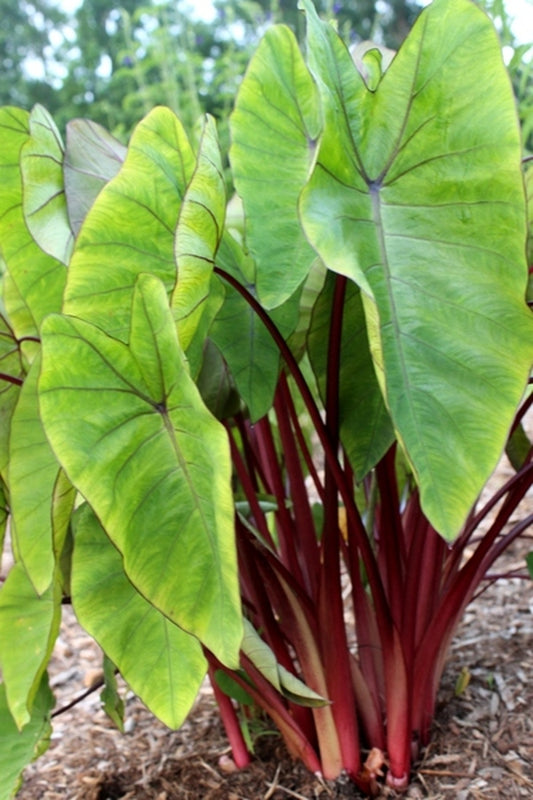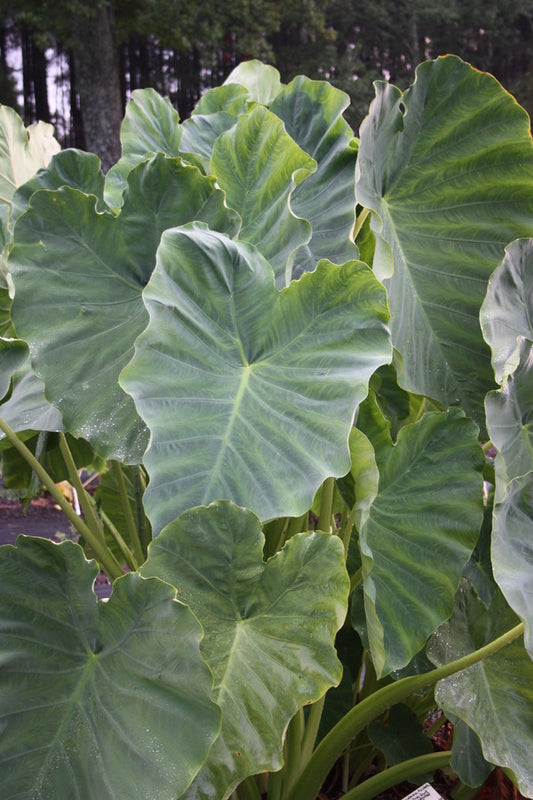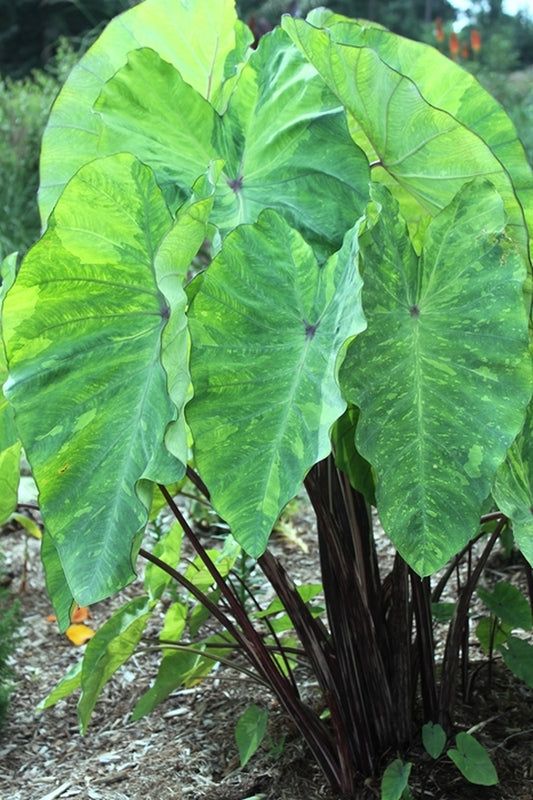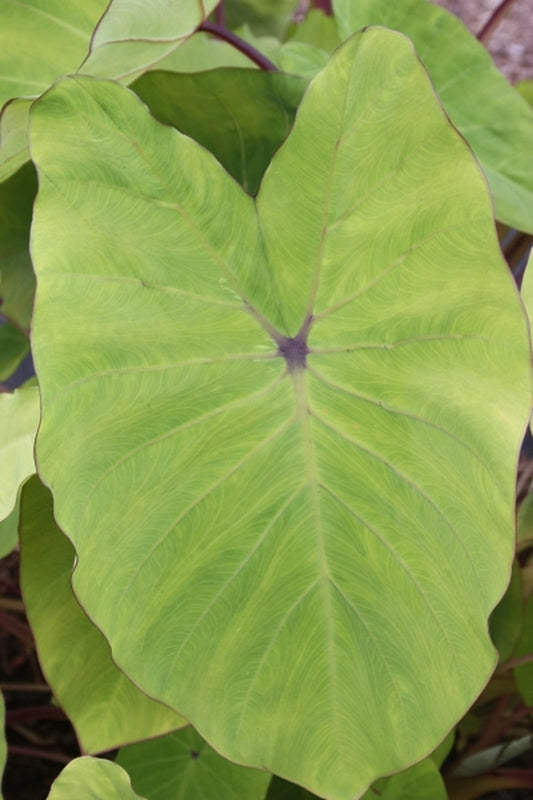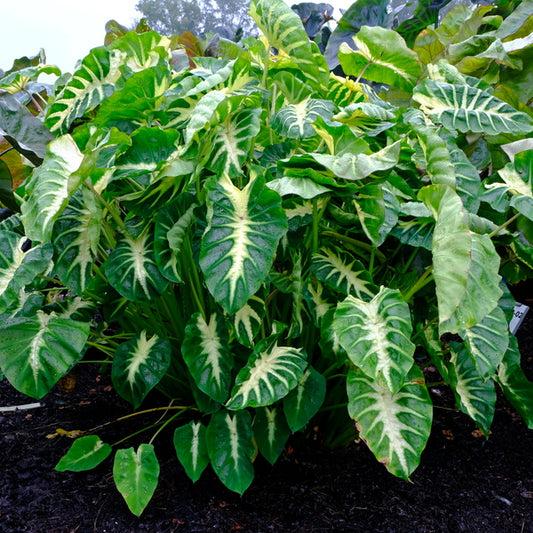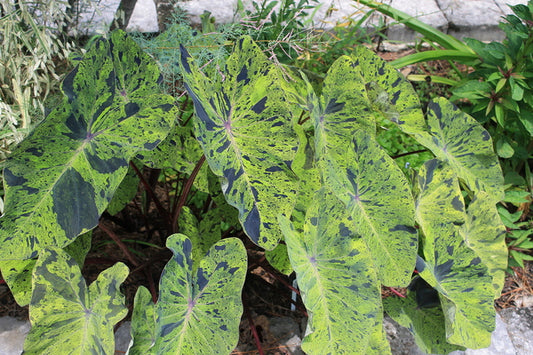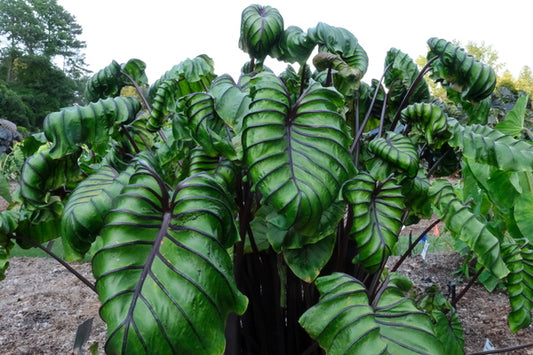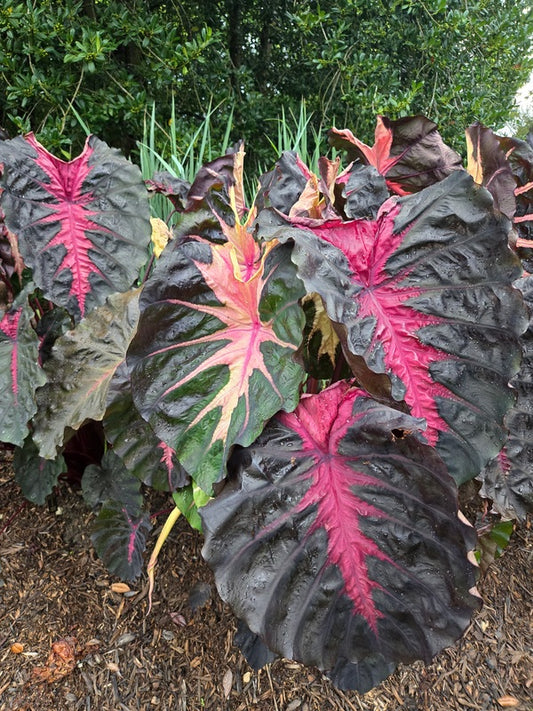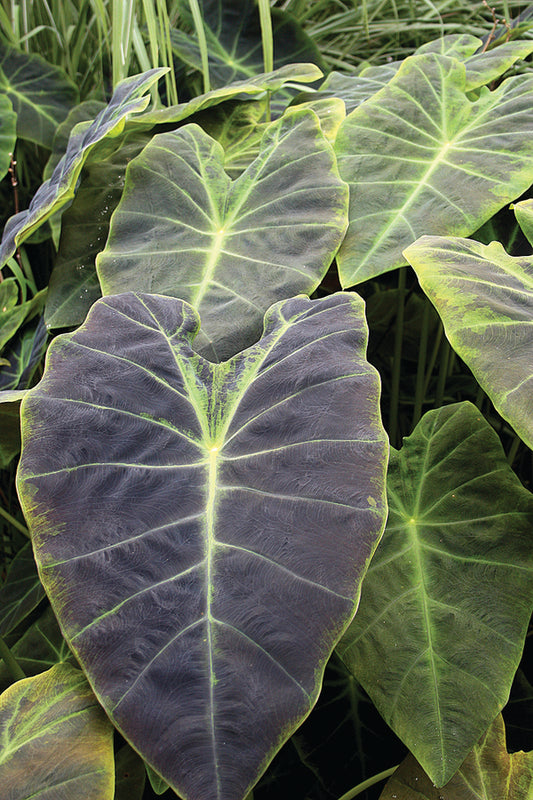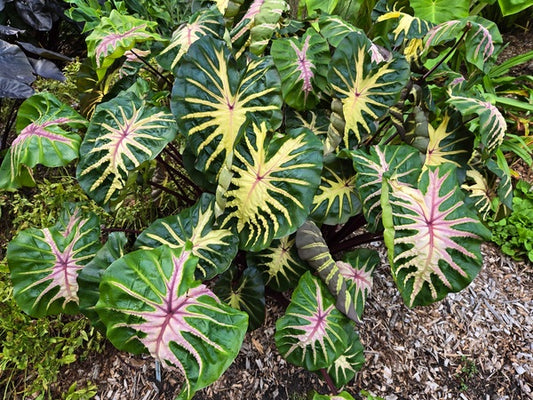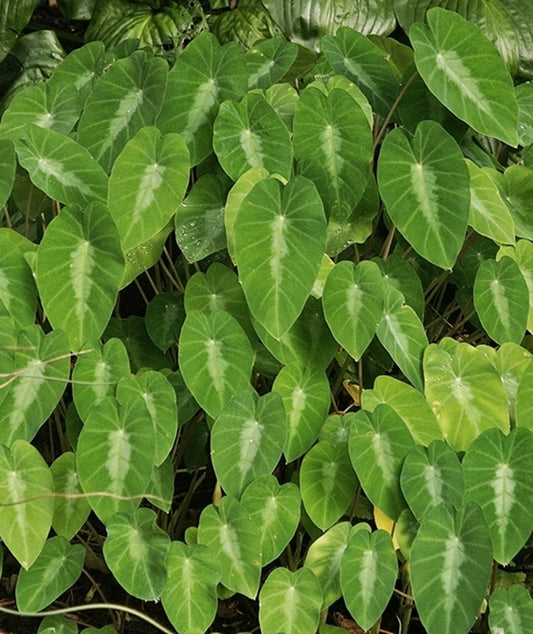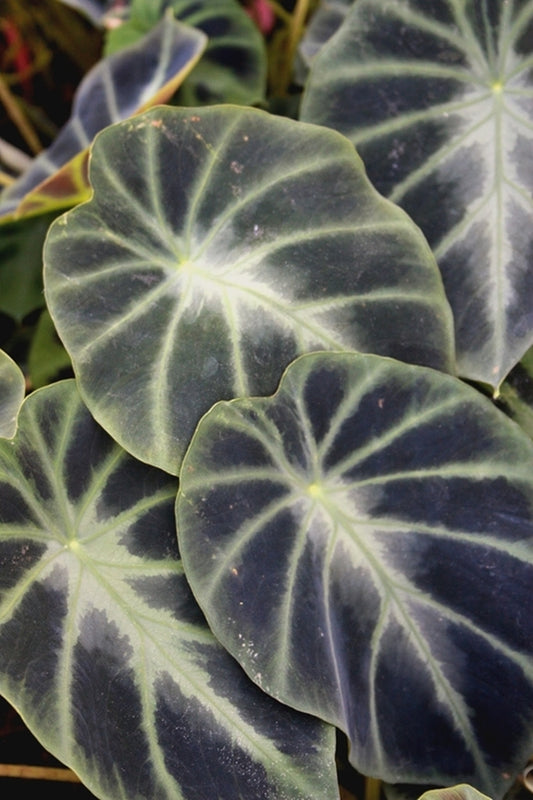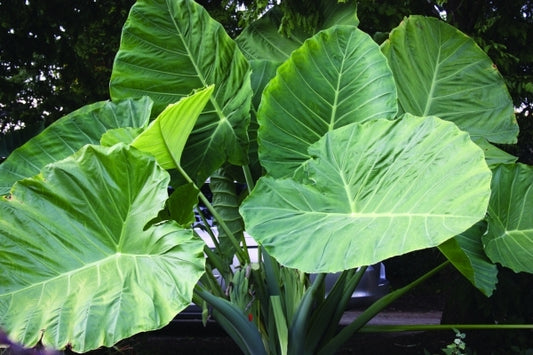The Colocasia for sale from Plant Delights Nursery differ from the mundane green, box-store varieties. We offer many new and hard-to-find colocasia selections with unique, colorful leaves and stems as well as giant elephant ear plants like Thailand Giant. Whether you are looking for a chartreuse, red, or black elephant ear, we have what you want...even variegated elephant ears. We are particularly excited to offer the new Royal Hawaiian® series of colocasia for sale from Hawaiian elephant ear breeder, Dr. John Cho. Although Colocasia esculenta is the main species grown in gardens and as commercial taro plants, we also offer other hard to find exotic species of elephant ear plants including Colocasia gigantea (Leucocasia gigantea), Colocasia fallax, and Colocasia affinis.
-
Colocasia 'Coffee Cups'
Item #: 6668
Zones: 8a to 10b
Dormancy: Winter
Height: 72" tall
Culture: Sun
Origin: Asia
Pot Size: 3.5" pot (24 fl. oz/0.7 L)
Regular price $26.00Regular priceUnit price per -
Colocasia esculenta 'Aloha' PP 29,692
Item #: 12989
Zones: 7b to 10b
Dormancy: Winter
Height: 48" tall
Culture: Sun to Part Sun
Origin: Eastern Asia
Pot Size: 3.5" pot (24 fl. oz/0.7 L)
Regular price $27.00Regular priceUnit price per -
Colocasia esculenta 'Black Coral' PP 23,896
Item #: 9580
Zones: 7b to 10b
Dormancy: Winter
Height: 42" tall
Culture: Sun to Part Sun
Origin: Eastern Asia
Pot Size: 3.5" pot (24 fl. oz/0.7 L)
Regular price $27.00Regular priceUnit price per -
Colocasia esculenta 'Black Magic'
Item #: 1818
Zones: 7b to 10b
Dormancy: Winter
Height: 60" tall
Culture: Sun to Part Sun
Origin: Eastern Asia
Pot Size: 3.5" pot (24 fl. oz/0.7 L)
Regular price $24.00Regular priceUnit price per -
Colocasia esculenta 'Blue Hawaii' PP 20,003
Item #: 8042
Zones: 7b to 10b
Dormancy: Winter
Height: 30" tall
Culture: Sun
Origin: Eastern Asia
Pot Size: 3.5" pot (24 fl. oz/0.7 L)
Regular price $27.00Regular priceUnit price per -
Colocasia esculenta 'Hawaiian Punch' PP 24,596
Item #: 2469
Zones: 7b to 10b
Dormancy: Winter
Height: 36" tall
Culture: Sun to Part Sun
Origin: Eastern Asia
Pot Size: 3.5" pot (24 fl. oz/0.7 L)
Regular price $27.00Regular priceUnit price per -
Colocasia esculenta 'Jack's Giant'
Item #: 7400
Zones: 7a to 10b, at least
Dormancy: Winter
Height: 84" tall
Culture: Sun to Part Sun
Origin: Eastern Asia
Pot Size: 3.5" pot (24 fl. oz/0.7 L)
Regular price $27.00Regular priceUnit price per -
Colocasia esculenta 'Lemon-Lime Gecko'
Item #: 4915
Zones: 7b to 10b
Dormancy: Winter
Height: 54" tall
Culture: Sun to Part Sun
Origin: Eastern Asia
Pot Size: 3.5" pot (24 fl. oz/0.7 L)
Regular price $27.00Regular priceUnit price per -
Colocasia esculenta 'Maui Gold' PP 24,482
Item #: 2032
Zones: 7b to 10b
Dormancy: Winter
Height: 48" tall
Culture: Sun to Part Sun
Origin: Eastern Asia
Pot Size: 3.5" pot (24 fl. oz/0.7 L)
Regular price $27.00Regular priceUnit price per -
Colocasia esculenta 'Maui Sunrise' PP 31,175
Item #: 14267
Zones: 7b to 10b
Dormancy: Winter
Height: 36" tall
Culture: Sun to Part Sun
Origin: Eastern Asia
Pot Size: 3.5" pot (24 fl. oz/0.7 L)
Regular price $27.00Regular priceUnit price per -
Colocasia esculenta 'Mojito' PP 21,995
Item #: 8545
Zones: 7b to 10b
Dormancy: Winter
Height: 36" tall
Culture: Sun to Part Sun
Origin: Eastern Asia
Pot Size: 3.5" pot (24 fl. oz/0.7 L)
Regular price $27.00Regular priceUnit price per -
Colocasia esculenta 'Pharaoh's Mask' PP 33,772
Item #: 15723
Zones: 7b to 10b
Dormancy: Winter
Height: 42" tall
Culture: Sun to Part Sun
Origin: Eastern Asia
Pot Size: 3.5" pot (24 fl. oz/0.7 L)
Regular price $30.00Regular priceUnit price per -
Colocasia esculenta 'Redemption' PP 34,729
Item #: 17918
Zones: 7b to 10b
Dormancy: Winter
Height: 48" tall
Culture: Sun to Part Sun
Origin: Eastern Asia
Pot Size: 3.5" pot (24 fl. oz/0.7 L)
Regular price $35.00Regular priceUnit price per -
Colocasia esculenta var. antiquorum 'Black Beauty'
Item #: 7727
Zones: 7a to 10b
Dormancy: Winter
Height: 30" tall
Culture: Sun to Light Shade
Origin: Eastern Asia
Pot Size: 3.5" pot (24 fl. oz/0.7 L)
Regular price $27.00Regular priceUnit price per -
Colocasia esculenta 'Waikiki' PP 34,615
Item #: 17034
Zones: 7b to 10b
Dormancy: Winter
Height: 42" tall
Culture: Sun to Part Sun
Origin: Eastern Asia
Pot Size: 3.5" pot (24 fl. oz/0.7 L)
Regular price $30.00Regular priceUnit price per -
Colocasia fallax
Item #: 2600
Zones: 7b to 10b
Dormancy: Winter
Height: 18" tall
Culture: Part Sun to Shade
Origin: China, Thailand, Vietnam
Pot Size: 3.5" pot (24 fl. oz/0.7 L)
Regular price $27.00Regular priceUnit price per -
Colocasia heterochroma 'Dark Shadows'
Item #: 6124
Zones: 8a to 10b
Dormancy: Winter
Height: 8" tall
Culture: Part Sun to Light Shade
Origin: China
Pot Size: 3.5" pot (24 fl. oz/0.7 L)
Regular price $26.00Regular priceUnit price per -
Colocasia (Leucocasia) gigantea 'Thailand Giant'
Item #: 5896
Zones: 8a to 10b
Dormancy: Winter
Height: 108" tall
Culture: Sun to Part Sun
Origin: Thailand
Pot Size: 3.5" pot (24 fl. oz/0.7 L)
Regular price $30.00Regular priceUnit price per
More Information About Colocasia
Colocasia are easy to grow and are among the most popular and eye-catching of all herbaceous perennials. Whether you need a smaller container plant or a massive tropical-looking center piece, colocasia offer plenty of color and variety and many variations are amazingly hardy.
How to Grow and Care for Colocasia
When to Plant
Colocasia, like many tropical aroids, will not start to grow vigorously until the summer temperatures escalate into the upper 80's. Just like real elephants, elephant ears like it hot. Like many semi-tropical plants that have some cold hardiness, elephant ears should be well established prior to the onset of cold weather in zones where they are winter hardy outdoors in the ground. If you buy Colocasia for your garden, then it is better to do so earlier in the year rather than later.
Where to Plant
In all but the hottest climates, colocasia enjoy full sun. We find that foliage will begin to scorch if temperatures exceed the low 90s, although the plants will recover once the heat wave passes. Plant 3 to 6 ft. (1-2 meters) apart in an area with good drainage. If you live in a climate colder than Zone 7b, consider treating your colocasia as a container plant so that it can easily be overwintered indoors.
Fertilizing
Elephant ears are heavy feeders, so if your plant isn't growing enough, you either need more water, more sun, more organic fertilizer, or compost. As a general rule-of-thumb, more water + more nutrients = more elephant ear.
Water and Soil Requirements
Although suitable for tropical-like, soggy conditions, the cold-hardiness of colocasia is increased in soil that has great drainage and is not soggy during the winter.
How to Overwinter
Colocasia tubers eventually work their way upward through the soil, so every few years, re-bury your Colocasia at least 4" deep to ensure winter hardiness. Where Colocasia remain in the ground over winter, they will be quite late to re-emerge in late spring or early summer, unless covered with 3-6" of mulch in early fall. A few of the newer colocasia cultivars do not form large tubers and, if dug in winter, cannot be stored dry due to a lack of adequate food reserves. These small-tuber elephant ears are best over-wintered in containers in a cool basement or garage that remains 15-20 degrees above freezing. In colder climates, elephant ears can be grown in containers and brought indoors to overwinter.
Pests and Diseases
Colocasia are susceptible to corm rot (caused by the fungus Pythium) if not planted in soil with adequate drainage, especially during winter. Dasheen mosaic potyvirus (DsMV) is a common pathogen of many aroids, including colocasia, and can be spread by aphids.
Types of Colocasia
There are both running and clumping varieties. Be careful where you plant the running varieties, since they can spread to 20 ft. (6 m.) quite rapidly in moist, rich soils. The clumping varieties are much more suitable to most gardens, and come in a range of sizes from a couple of feet tall to over 5 ft. (1.5 m.) in height. The basic leaf color is green, but there are now varieties with an array of foliage pattern on top of the green base. Also, a number of purple foliage varieties are now available.
Propagating Colocasia
Colocasia are propagated by division. Some colocasia grow from rhizomes, while others grow from larger corms. All can be easily divided when the plants are large enough.
Usage in Landscape Design
Colocasia do great as pond marginals or as rain garden plants. They are also frequently used as accent container plants outdoors, but don’t make particularly good indoor specimens, because they will not get enough light indoors to color well, and are more prone to insects in indoor conditions where humidity is lower and air is drier.
Toxicity
While many species of colocasia (Taro) are used in traditional Asian cuisine, all parts of the taro plant produce calcium oxalate and are poisonous to humans if ingested raw. Some gardeners may even be sensitive to the leaves so use caution when cutting. If cooked thoroughly, the taro tubers are rich in vitamins A and C and have more protein, calcium, and phosphorous than a potato.
Colocasia Companion Plants
- Baptisia (False Indigo)
- Ornamental Grasses
- Sedum (Stonecrop)
- Hardy Hibiscus (Swamp Rose Mallow)
- Echinacea (Cone Flower)
- Kniphofia (Red Hot Poker)
- Sabal Palm (Palmetto Palm)
Additional Resources
For more detailed information about how to grow and care for colocasia, check out our in-depth article Cool Colocasias – Elephant Ears in the Garden. Also, be sure to explore our many colocasia blog posts over on the Juniper Level Botanic Garden blog.


